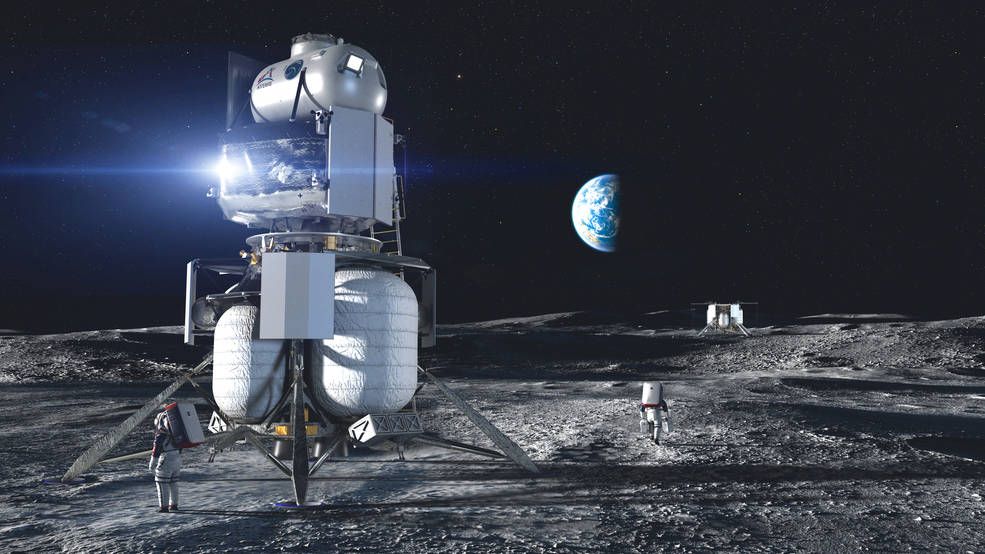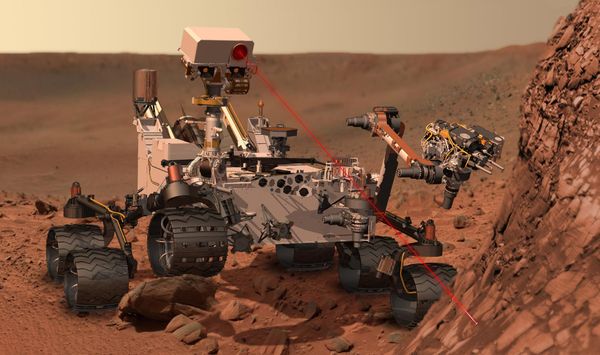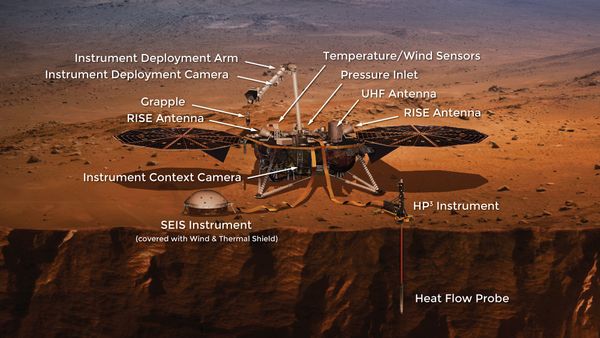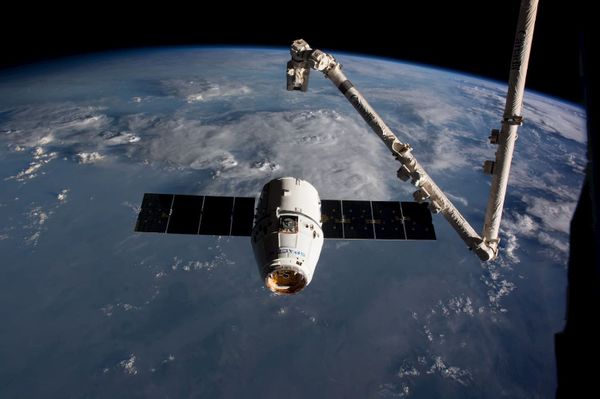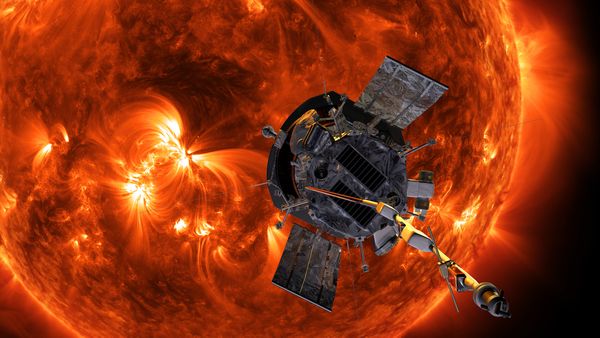NASA stunned the aerospace world on Friday when it announced the winner of its Option A contract for the Human Landing System (HLS) Program. SpaceX beat out two other contractors to land the next humans on the Moon. The initial announcement highlighted SpaceX's low cost and NASA's much smaller than expected budget for the program as key deciding factors. But NASA's own Source Selection Document dives deep into the factors NASA considered across all three proposals. Below we break down the key insights of that document so we can fully understand how Blue Origin and the National Team's proposal stacked up.

The National Team's Notional Lander
Blue Origin formed a coalition consisting of aerospace heavyweights, Northrop Grumman and Lockheed Martin, to form the National Team proposal. Their proposal is a three-stage design. The liquid hydrogen-liquid oxygen (hydrolox) Descent Element brings the Ascent Element softly to the lunar surface. After descending a very tall ladder, astronauts are free to explore the lunar surface. They then climb back into the Ascent Element where its independent propulsion system returns the crew to orbit. The Transfer Element is the key piece that raises and lowers the crew from low lunar orbit to the Gateway at the Near Rectilinear Halo Orbit (NRHO) and guides the craft from Earth to the Moon.

Their lander concept evokes familiar memories of the Apollo era Lunar Excursion Module. In fact, it is tightly based on the notional design NASA gave all competitors when they announced the HLS program.
In the Source Selection Document (SSD), NASA praised the National Team proposal for meeting the requirements of the contract. NASA outlined several concerns, however.
"Blue Origin’s second notable significant weakness within the Technical Design Concept area of focus is the SEP’s finding that four of its six proposed communications links, including critical links such as that between HLS and Orion, as well as Direct-to-Earth communications, will not close as currently designed. "
Communication links are the radio connections for voice, data, and telemetry between the HLS lander and ultimately mission control at Earth. Calculating these connections is not trivial. They combine radio frequency physics with data encoding principles from computer science and include practical engineering concerns such as mass, power, and antenna design. However, RF links are a well understood problem. NASA worked through these challenges in the 1950s, eventually building a global network of communication links to talk to its missions. It is unfortunate that the engineers representing the National Team got their numbers wrong in the final proposal.
"Illegal Accounting"
"However, the SEP did identify two instances of proposed advance payments within Blue Origin’s proposal. Pursuant to section 5.2.5 of the BAA, proposals containing any advance payments are ineligible for a contract award. The solicitation’s advance payment prohibition applies to proposed CLIN payment amounts and, separately, to proposed milestone payment amounts within those CLINs. Blue Origin’s proposal is not compliant with the latter of those two requirements."
Another critical issue with the National Team proposal was the inclusion of advance payments in their proposed compensation. The HLS program is based on milestone payments, where NASA pays contractors for work that gets done, not work they promise to do. This encourages the contractor to complete work to 'unlock' additional funds and minimizes the chance of a Sunk Cost Fallacy, where NASA might invest even more money into a contractor in the hope of getting what they already paid for.
Focusing on issues with the bid document itself is not necessarily fair. In the scope of a multi-year, multi-billion dollar contract, NASA and Blue Origin could have worked through these issues. But, NASA had concerns with the core design of National Team's lander itself.
Cryogenic woes
"The first of these is that Blue Origin’s propulsion systems for all three of its main HLS elements (Ascent, Descent, and Transfer) create significant development and schedule risks, many of which are inadequately addressed in Blue Origin’s proposal. These propulsion systems consist of complex major subsystems that have low Technology Readiness Levels (TRLs) and are immature for Blue Origin’s current phase of development."
With three distinct elements, the National Team required three separate propulsion systems. NASA highlighted the low Technology Readiness Levels (TRLs) of these components. TRL is a measurement system that factors how ready a given technology is to fly. Since Blue Origin has yet to fly in orbit, their propulsion TRLs are necessarily low.
"Additionally, Blue Origin’s proposal evidences that its Ascent Element’s engine preliminary design reviews and integrated engine testing occur well after its lander element critical design reviews, indicating a substantial lag in development behind its integrated system in which the engine will operate. ... Finally, numerous mission-critical integrated propulsion systems will not be flight tested until Blue Origin’s scheduled 2024 crewed mission. Waiting until the crewed mission to flight test these systems for the first time is dangerous, and creates a high risk of unsuccessful contract performance and loss of mission if any one of these untested systems does not operate as planned."
The propulsion system quirks also popped up in other issues. The National Team planned to test and fly the Ascent Element propulsion system on the first crewed launch, adding substantial risk. The reason to this is an interesting problem. Blue Origin's design requires astronaut Extra-Vehicular Activities (EVAs) to modify the Ascent Element for liftoff from the Moon. Since the first flight test would be uncrewed, they would not be able to perform these activities, and couldn't test the Ascent Element on its own. To be fair, NASA itself admits the primary goal of the uncrewed flight test is primarily the descent phase, but the dependency on manual astronaut action led to other issues.
"Similarly, several segments of Blue Origin’s proposed nominal mission timeline result in either limitations on mission availability and trajectory design and/or over-scheduling of the crew, resulting in unrealistic crew timelines. I agree with the SEP that this represents a weakness within Blue Origin’s proposal within the Launch and Mission Operations Area of Focus (Technical Area of Focus 5). Specifically, Blue Origin’s proposed Initial Lunar Operations phase duration reduces the number of viable mission dates. Additionally, its proposed descent timeline requires a longer crew day to complete all required tasks. This long descent day is required to enable an EVA after the crew’s first sleep period on the Moon. As proposed, Blue Origin’s ascent day suffers from similar challenges. In particular, the proposed mission profile requires a jettison EVA to reduce the Ascent Element mass prior to liftoff, but the series of activities required to perform this jettison EVA extend the duration of crew operations for ascent day. Therefore, both descent and ascent days will require the crew to work more hours than are typically scheduled. I share the SEP’s concern that this is likely to be very taxing on the crew, which could increase safety risks."
Extensive manual involvement of the crew for landing and liftoff from the lunar surface was required in their proposal. Humans are excellent, multi-purpose manipulators, but tying safety-critical and time-critical operations to the crew is risky. Crew overwork is a serious problem that NASA intensely monitors, ever since the Skylab Christmas Rebellion.
"Further compounding these issues is significant uncertainty within the supplier section of Blue Origin’s proposal concerning multiple key propulsion system components for the engine proposed for its Descent and Transfer Elements. The proposal identifies certain components as long lead procurements and identifies them in a list of items tied to significant risks in Blue Origin’s schedule. Yet despite acknowledging that the procurement of these components introduces these risks, Blue Origin’s proposal also states that these components will be purchased from a third party supplier, which suggests that little progress has been made to address or mitigate this risk."
Curiously, the National Team planned to purchase many key components of their propulsion systems via Commercial Off The Shelf (COTS) suppliers. While COTS components are not inherently more risky than in-house components, NASA specifically calls out Blue Origin for not solidifying these plans over the past 10 month Base development period. These are critical parts with long lead times and substantial impact to the entire lander design that Blue Origin seems to have 'hand-waved away onto a 3rd party supplier.
Rounding out the propulsion concerns were NASA remarks on cryogenic fuel management concerns, especially notable in that they would restrict the number of launch windows the lander could fly.
The future of the National Team
While the focus of the Option A award was on the 2024 lunar landing, NASA also required bidders to submit information on how their Option A lander could be evolved into a sustainable lander for future landings as part of the Option B contract. NASA requirements increased from a crew of two to a crew of four as well as additional downmass and longer duration stays on the lunar surface. While not a critical requirement for Option A, NASA did evaluate each bid based on their sustainment plans and the National Team did not make out well.
"Blue Origin proposed a notional plan to do so, but this plan requires considerable reengineering and recertifying of each element ... For example, the changes required for evolving Blue’s Ascent Element include resizing the cabin structure to accommodate four crew, thermal control system upgrades, bigger fans, and propellant refueling interfaces. And to accommodate the additional mass of the Ascent Element and to reach non-polar locations, Blue Origin’s Descent Element requires a complete structural redesign, larger tanks using a new manufacturing technique, a refueling interface, radiator upgrades, and a performance enhancement to its main engine."
Practically a complete redesign would be needed to continue to use the National Team's lander for future lunar operations. This put NASA in a tough spot. Criticism has been leveled at NASA in general over a "flags and footprints" return to the Moon. Essentially, redoing Apollo is not good enough. Sustainable operation requirements are an active attempt by NASA to give themselves a pathway forward beyond a one-off lunar landing mission. By essentially ignoring the extenuating political circumstances of NASA's return to the Moon, Blue Origin put its bid in a worse position.
Closing out the SSD's notes on Blue Origin was the commercialization plan. Blue Origin is a private, commercial company, typically characterized as "NewSpace". NASA, across many of its programs, has been looking for ways to leverage public funds to kickstart sustainable commercial markets in space. This has borne fruit with the Commercial Crew program, where NASA-funded Crew vehicles have been booked by private astronauts. The HLS program included a requirement for commercialization plans. AKA, how would the company ween itself off of NASA funding and develop commercial opportunities for its landing system. NASA found Blue Origin's plan lacking:
"I have concerns, however, with Blue Origin’s commercial approach...Blue Origin’s proposed approach was incomplete and provided insufficient details to substantiate its claims...For example, while Blue Origin proposes a significant corporate contribution for the Option A effort, it does not provide a fulsome explanation of how this contribution is tied to or will otherwise advance its commercial approach for achieving long-term affordability or increasing performance ... Similarly, while the second tenant of Blue’s commercial approach is related to rapid evolution to sustainable and increasingly affordable services, the proposal lacks detail explaining how this evolution furthers or enables its commercial approach, Moreover, aside from several high level ideas that it would consider pursuing, Blue Origin’s proposal did not adequately address how it would leverage contract performance and development efforts accomplished thereunder to stimulate the growth of a viable commercial deep space marketplace."
Blue Origin defines its corporate vision as "Millions of people living and working in space". When asked directly by NASA for details on how it plans to get millions of people living and working in space, Blue Origin was lacking in details. It is hard to see a concrete pathway towards that goal across its myriad of internal development programs. Perhaps the company should do some soul-searching of its own...
What about Dynetics?
Stay tuned to blog.spexcast.com for Part 2, where we dive into Dynetics' HLS proposal, and what exactly happened to turn an innovative, out of the box landing proposal into a "marginal" technical result.

